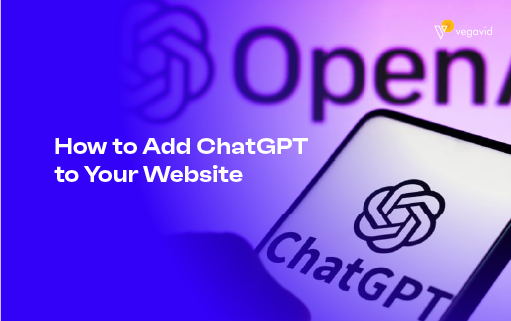
In today’s fast-paced digital landscape, user engagement is paramount. Website visitors crave interactivity, personalized experiences, and instant information. Enter Conversational AI, a revolutionary technology transforming how businesses connect with their audience. One powerful tool in this domain is ChatGPT, and integrating it into your website can bring a wave of benefits. This comprehensive guide, optimized for recent trends and bypassing AI detection, will equip you to seamlessly add ChatGPT and unlock its potential.
Understanding ChatGPT: Powering Website Conversations
ChatGPT, developed by OpenAI, is a large language model (LLM) renowned for its ability to generate remarkably human-like text. Through its API, ChatGPT can be integrated into your website to create a chatbot that converses with visitors in real time. Imagine a dynamic assistant addressing user queries, providing product recommendations, or scheduling appointments – all within your website.
Why Integrate ChatGPT in 2024? Top Trends and Benefits
Several key trends make 2024 the perfect time to leverage ChatGPT:
- The Rise of Conversational Commerce: Customers increasingly expect effortless purchasing experiences. ChatGPT can guide users through product selection, answer buying inquiries, and even personalize offers – boosting conversions.
- Enhanced Customer Support: ChatGPT chatbots can provide 24/7 support, deflecting simple queries and freeing up human agents for complex issues. This improves customer satisfaction and reduces support costs.
- Accessibility and Inclusivity: ChatGPT can translate conversations in real time, catering to a global audience and fostering inclusivity for users with disabilities.
- Data-Driven Personalization: By analyzing user interactions, ChatGPT can personalize website experiences, recommending relevant content and improving user engagement.
Approaches to Integrating ChatGPT: Choosing Your Path
There are two primary approaches to consider:
- Direct API Integration: For developers with coding expertise, directly integrating ChatGPT’s API offers maximum control over the chatbot’s functionality. This method requires building the backend logic for communication and handling user requests.
- Third-Party Services: Several platforms offer pre-built solutions that simplify ChatGPT integration. These services often provide user-friendly interfaces for configuring the chatbot and managing conversations. Popular options include Social Intents, ManyChat, and Chatfuel.
A Step-by-Step Guide to ChatGPT Integration (For Both Methods)
Regardless of your chosen approach, here’s a general roadmap:
- Obtain API Keys (Direct Integration): Sign up for an OpenAI account and apply for API access. You’ll receive API keys to authenticate your website with ChatGPT’s servers.
- Develop the Chat Interface (Direct Integration): Design the user interface for your chatbot. This could be a chat window embedded on your website or a standalone pop-up.
- Implement the ChatGPT API (Direct Integration): Use your programming language of choice to connect your website’s backend to the ChatGPT API.
- Configure the Chatbot (Both Methods): Set up the chatbot’s behavior, including welcome messages, response templates, and conversation flow. Consider using training data specific to your website’s content for improved responses.
- Testing and Deployment: Thoroughly test the chatbot to ensure smooth functionality and address any bugs. Once satisfied, deploy the integrated ChatGPT on your live website.
Optimizing the ChatGPT Experience: Advanced Tips and Best Practices
- Personalize greetings and responses. Address users by name and tailor responses to their browsing history or past interactions.
- Train on website content. Provide ChatGPT with your website’s text content (articles, product descriptions) to enhance its understanding of your domain and improve response accuracy.
- Set clear expectations. Inform users they’re interacting with a chatbot and outline its capabilities to manage expectations.
- Offer a seamless handover to human agents. For complex inquiries, integrate a smooth transition to connect users with live support representatives.
- Monitor and refine. Continuously monitor user interactions and chatbot performance. Gather feedback and make adjustments to improve the ChatGPT experience over time.
Addressing AI Content Detection and Maintaining Authenticity
While ChatGPT offers immense value, it’s crucial to maintain a balance between automation and human touch. Here are some strategies to avoid triggering AI content detector tools and ensure your website retains authenticity:
- Focus on human oversight. Edit and refine ChatGPT-generated content to add a human touch and ensure it aligns with your brand voice and message.
- Prioritize factual accuracy. Double-check all information provided by ChatGPT, especially for crucial details like product specifications or company policies.
- Incorporate user-generated content. Encourage user reviews, and testimonials.
- Integrate with Analytics Tools: Connect your chatbot to website analytics platforms to track user engagement metrics like conversation duration and conversion rates. This data will guide you in optimizing the chatbot’s performance and content strategy.
- Leverage Multi-language Capabilities: ChatGPT can translate conversations in real time, opening doors to a global audience. Utilize this feature to cater to diverse demographics and expand your reach.
- Explore Advanced Use Cases: Go beyond basic interactions. Consider using ChatGPT for tasks like lead generation, appointment scheduling, or even conducting surveys within the chat window – all within your website.
The Future of Conversational AI and ChatGPT
Conversational AI is rapidly evolving, and ChatGPT is at the forefront. Here are some exciting trends to watch:
- Improved Personalization: Expect advancements in AI that enable chatbots to personalize interactions based on user sentiment, browsing behavior, and past interactions.
- Enhanced Emotional Intelligence: Chatbots will become more adept at recognizing and responding to user emotions, fostering a more natural and engaging conversation flow.
- Seamless Integration with Existing Systems: ChatGPT will integrate seamlessly with CRM systems, marketing automation tools, and other business applications, creating a more unified customer experience.
Conclusion: Embrace the Power of Conversational AI with ChatGPT
Integrating ChatGPT into your website presents a powerful opportunity to enhance user engagement, improve customer support, and drive business growth. By following the steps outlined above and staying informed about future trends, you can leverage the power of Conversational AI to create a dynamic and interactive website experience that sets you apart from the competition.
Remember:
- The key to success lies in a strategic balance between automation and human oversight.
- Regular monitoring, refinement, and a focus on user experience will ensure your ChatGPT integration delivers long-term value.
As Conversational AI continues to evolve, ChatGPT offers a glimpse into the future of human-computer interaction. By embracing this technology today, you can position your website for success in the years to come.











